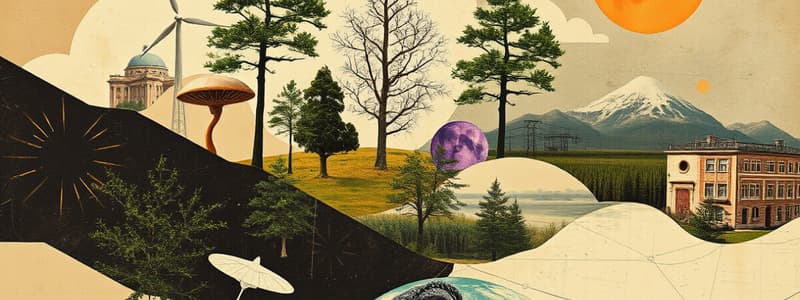Podcast
Questions and Answers
What is an ecosystem?
What is an ecosystem?
An ecosystem is a community of living organisms interacting with their physical environment in a specific area.
What are biotic factors in an ecosystem?
What are biotic factors in an ecosystem?
Biotic factors include plants, animals, fungi, and microorganisms.
Give two examples of abiotic factors.
Give two examples of abiotic factors.
Sunlight and water are two examples of abiotic factors.
What are the two main types of ecosystems?
What are the two main types of ecosystems?
How does energy flow through an ecosystem?
How does energy flow through an ecosystem?
What is the water cycle?
What is the water cycle?
Define primary succession.
Define primary succession.
What does biodiversity refer to?
What does biodiversity refer to?
How do human activities impact ecosystems?
How do human activities impact ecosystems?
What is ecological succession?
What is ecological succession?
Flashcards are hidden until you start studying
Study Notes
Ecosystem
-
Definition: An ecosystem is a community of living organisms (biotic factors) interacting with their physical environment (abiotic factors) in a specific area.
-
Components:
- Biotic Factors: Includes plants, animals, fungi, and microorganisms.
- Abiotic Factors: Includes sunlight, temperature, soil, water, and air.
-
Types of Ecosystems:
- Terrestrial Ecosystems: Forests, grasslands, deserts, and tundras.
- Aquatic Ecosystems: Freshwater (lakes, rivers) and marine (oceans, coral reefs).
-
Energy Flow:
- Begins with producers (e.g., plants) that convert solar energy into chemical energy through photosynthesis.
- Energy moves through the ecosystem via food chains and food webs:
- Producers → Primary consumers (herbivores) → Secondary consumers (carnivores) → Tertiary consumers.
-
Nutrient Cycling:
- Key cycles include:
- Water Cycle: Evaporation, condensation, precipitation.
- Carbon Cycle: Photosynthesis, respiration, decomposition.
- Nitrogen Cycle: Nitrogen fixation, nitrification, denitrification.
- Key cycles include:
-
Ecological Succession:
- Primary Succession: Development of an ecosystem in a previously uninhabited area (e.g., after a volcanic eruption).
- Secondary Succession: Regeneration of an ecosystem following disturbance (e.g., after a forest fire).
-
Biodiversity:
- Refers to the variety of life in an ecosystem, including species diversity, genetic diversity, and ecosystem diversity.
- High biodiversity enhances resilience and stability of ecosystems.
-
Human Impact:
- Urbanization, deforestation, pollution, and climate change affect ecosystems.
- Conservation efforts aim to protect and restore ecosystems.
-
Ecosystem Services:
- Benefits provided by ecosystems to humans, including:
- Provisioning services (food, water)
- Regulating services (climate regulation, flood control)
- Cultural services (recreational, spiritual)
- Supporting services (nutrient cycling, soil formation).
- Benefits provided by ecosystems to humans, including:
Ecosystem Overview
- An ecosystem comprises biotic (living) and abiotic (non-living) components interacting within a specific area.
Components of Ecosystems
- Biotic Factors: Encompasses plants, animals, fungi, and microorganisms that contribute to the living aspect of ecosystems.
- Abiotic Factors: Consists of elements like sunlight, temperature, soil, water, and air that influence the environment.
Types of Ecosystems
- Terrestrial Ecosystems: Various forms include forests, grasslands, deserts, and tundras with different climate and biodiversity.
- Aquatic Ecosystems: Divided into freshwater ecosystems (lakes, rivers) and marine ecosystems (oceans, coral reefs), hosting diverse life forms.
Energy Flow
- Energy begins with producers like plants that utilize photosynthesis to convert solar energy into chemical energy.
- Energy transitions through the food chain:
- Producers → Primary consumers (herbivores) → Secondary consumers (carnivores) → Tertiary consumers.
Nutrient Cycling
- Water Cycle: Involves processes such as evaporation, condensation, and precipitation.
- Carbon Cycle: Consists of photosynthesis, respiration, and decomposition that regulate carbon levels in the environment.
- Nitrogen Cycle: Incorporates nitrogen fixation, nitrification, and denitrification to maintain nitrogen balance in ecosystems.
Ecological Succession
- Primary Succession: The establishment of an ecosystem anew in a barren environment, like post-volcanic activity.
- Secondary Succession: Recovery of an ecosystem after a disturbance, for instance, following a forest fire.
Biodiversity
- Refers to the variety of life forms within an ecosystem, including species, genetic, and ecosystem diversity, enhancing ecosystem resilience and stability.
Human Impact
- Activities such as urbanization, deforestation, pollution, and climate change critically affect ecosystems.
- Conservation efforts are essential for protecting and restoring ecosystems to sustain biodiversity and ecological functions.
Ecosystem Services
- Ecosystems offer various benefits to humans, categorized into:
- Provisioning Services: Includes accessible resources like food and water.
- Regulating Services: Involves climate regulation and flood control functions.
- Cultural Services: Encompass recreational and spiritual benefits provided by nature.
- Supporting Services: Include processes like nutrient cycling and soil formation essential for sustaining life.
Studying That Suits You
Use AI to generate personalized quizzes and flashcards to suit your learning preferences.




